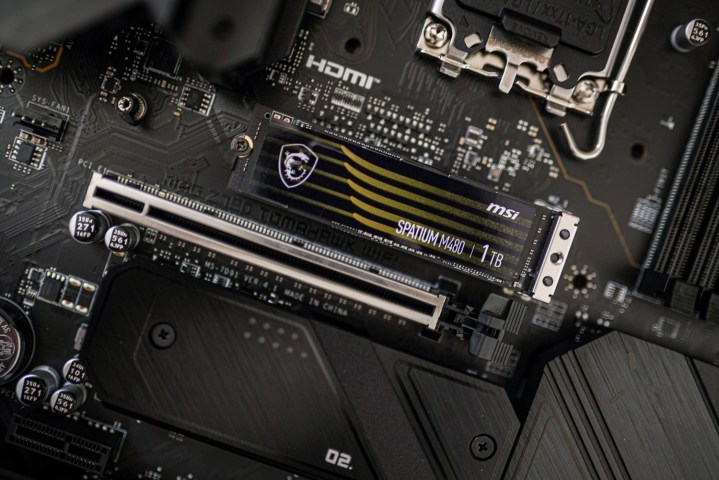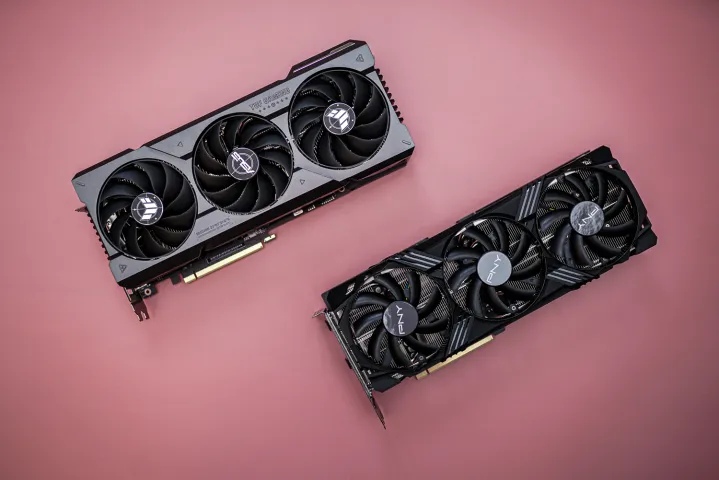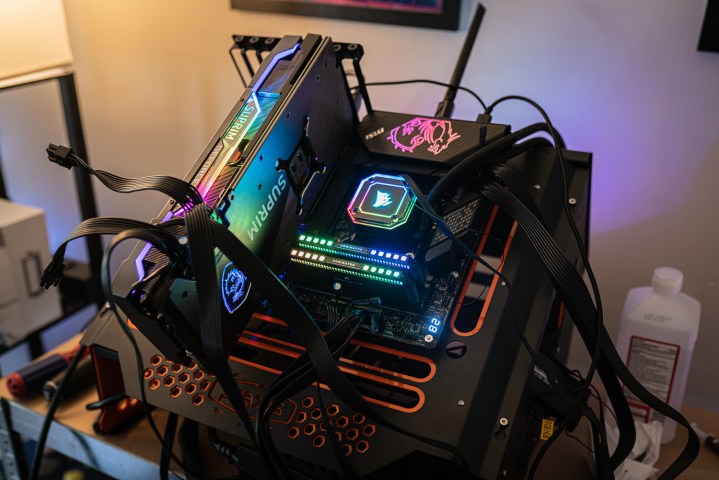
The beauty of owning a desktop PC lies in upgradability. It’s a huge part of why I always stick to desktops, and I can’t imagine having it any other way. A desktop is a canvas, one where you can erase certain parts and paint them anew at a whim. However, when it comes to deciding just what to upgrade, things get pretty tricky. After all, if you splurge too much, you might be better off just buying a whole new PC.
Prolonging the life of your desktop means going for impactful upgrades. This doesn’t necessarily mean spending the most money — it’s more about targeting the right components. Here are the four things I’d upgrade in my desktop if I wanted to give it a serious performance boost.
Upgrade to an SSD

If you still have an HDD in your PC, upgrading to an SSD is the single most impactful thing you can do. Even if you have a GPU from eight years ago, or a CPU that’s a few generations old, swapping those out won’t affect the way your entire PC runs as much as switching from an HDD to an SSD.
Buying an SSD will affect everything you do on your PC, but the most noticeable thing are boot times. With an SSD, you’ll experience much faster boot times, and I truly mean much faster — going down from a few minutes to as little as 10 seconds. File transfer becomes significantly faster, too, and let’s not forget things like loading screens in games. Some games are nearly unplayable without an SSD, which is why you’ll find it listed as a requirement for certain AAA titles these days.
When you shop, it’s important to consider whether your PC can handle an NVMe SSD — if not, you’ll need to stick to SATA. The latter is significantly slower, with read speeds reaching around 500MB/s as opposed to the 7,000MB/s and up that an NVMe SSD can provide. Even then, it’ll be a massive jump over an HDD. We talk about this at length in our SSD buying guide.
The days of HDDs are coming to an end, and even for the purpose of pure storage, SSDs are taking over. If you need a place to store a large amount of files, let’s say above 2TB, an HDD is still more cost-effective; but at 2TB and below, there’s no beating an SSD. Sure, a fast NVMe SSD will cost more than an HDD, but it’s usually a difference of $10 to $30, making it well worth the extra spend.
I still remember the day I got my first SSD. I’d already heard about those 20-second boot times, but it still absolutely blew my mind. If you still don’t have one, do yourself a favor and get one. Even a slower SATA SSD will be a game-changer, and if your motherboard supports using an NVMe SSD, well, you’re in for a treat.
One thing to remember, though, is that any future SSD to SSD upgrades won’t blow your mind quite as much. Everything will be faster, but it’s not going to make or break your experience whether you have a speedy SSD or a more reasonable budget model.
Get a GPU with more memory

When you have a spacious budget, upgrading your graphics card often marks a huge upgrade — but there are a few caveats to consider before you spend hundreds of dollars on a new GPU.
First, the benefits. There’s no denying that GPU upgrades can have the biggest impact on your games, sometimes adding dozens of frames per second (fps) and turning sluggish titles into a wonderfully seamless experience. Many games benefit from a faster GPU more so than from a faster processor, so it’s a pretty universal way to boost your favorite titles.
Getting a new GPU also tends to be easier than upgrading your CPU. Seeing as CPUs are limited by the socket type, it’s hard to get a really impactful upgrade without also swapping the motherboard. The only major difference you can hope for is if you’re upgrading from an entry-level processor to a high-end model, preferably one from a newer generation. Of course, a CPU with more cores will be better for multitasking, so it can be noticeable — but it also tends to be a pricier, more complicated affair. However, even if you buy a GPU, it’s not a given that this will be the only upgrade you need. You may often end up needing a new power supply, too.
The problem with upgrading your GPU is that it’s not always going to be a major difference. You might spend a lot of money on something that doesn’t change a whole lot.

For instance, let’s compare the RTX 4060 to the RTX 3060. The former unlocks access to Nvidia’s frame generation tech, DLSS 3, which can be great for gaming — but on the whole, there’s not much of a performance jump between the two. In our testing, the RTX 4060 averaged just 12 frames higher than its predecessor. For the RTX 4060 Ti, that gap is even smaller. As a result, you’re looking at a $300 expense that won’t net you any extra fps outside of games that support DLSS 3. On the other hand, upgrading from the aforementioned RTX 3060 to something like an RTX 4070 Super or an RTX 4070 Ti Super will make a significant difference.
There’s also one overlooked aspect when buying a GPU, and that’s video memory, or VRAM.
Games with high-quality textures require more VRAM. If the GPU doesn’t have enough VRAM, it will either lower texture quality or offload data to slower system RAM, impacting performance. It’s not just pure VRAM capacity that you need to worry about; the memory interface, or bus width, matters just as much. A narrow bus will stifle the bandwidth and result in poor performance, as we’ve seen in our review of the RTX 4060 Ti. It turned out to be slower than its predecessor in some of our tests despite having the same amount of VRAM, all because of the narrow bus.
These days, many GPUs with 8GB VRAM or less are starting to struggle. The rest of your PC can be great, but if your graphics card doesn’t have enough of its own, self-contained memory and a sufficiently wide memory interface, gaming performance is bound to take a hit. This is especially visible at higher resolutions, so if you want to switch to a 1440p monitor, 8GB will leave you on very thin ice.
Still, I don’t usually recommend buying a new GPU every generation. You’ll get the most bang for your buck if you shop once every two or three gens. This approach will let you stay current and play older and newer games alike with reasonable frame rates, but it’ll also keep you from overspending on incremental upgrades. The one thing that always negates that rule is VRAM. If your current GPU has 8GB VRAM, going up to 12GB or more will be impactful across nearly every game that you play.
Oh, and stay away from overclocked GPUs — they’re some of the biggest money wasters out there.
Upgrading to 32GB of RAM

I’m a huge PC building enthusiast and I’m a little nosy, so I tend to ask my friends all about their specs whenever I get the chance. I’m always surprised to find that many decent computers come with shockingly little memory. For instance, someone I know recently bought a prebuilt PC with an RTX 4090 and 16GB of RAM. (Prebuilts often come with mismatched specs just like that.) That just doesn’t add up.
Getting more RAM can really make an aging PC feel almost new. You’ll see an improvement in multitasking, overall system performance, data access and transfers, and gaming. In fact, games prompted me to include memory in this article, because many AAA titles are starting to ask for 32GB — and even those that don’t will benefit from the extra headroom.
If your PC is short on RAM, you’ll definitely feel it. Stuttering, errors, freezes, slow performance, and high disk usage due to something called disk paging (when the system has to rely on virtual memory instead of RAM) are all symptoms of low or failing memory.
These days, 8GB of RAM is only sufficient if all you need is a laptop for casually browsing the internet and other lightweight tasks. Anything above that, and 16GB becomes a minimum. As a gamer, I personally wouldn’t go below 32GB at this point. There’s a limit as to how much RAM you reasonably need, though, which we’ve covered in our RAM buying guide.
Remember, though, that while going from 8GB RAM to 16GB or 32GB will feel marvelous, upgrading RAM speeds within the same capacity may not feel as impactful. For instance, if your current RAM is DDR4-3200 and you’re upgrading to DDR4-3800 with tighter timings, your PC will run just slightly faster; you’ll probably hardly notice. That’s why I usually don’t recommend upgrading simply for the sake of faster RAM — go for capacity based on what you need and pick a frequency that suits your budget.
Switch out that stock cooler

Overheating is one of the more common PC problems, and unfortunately, a simple stock cooler might become the bane of your existence if your CPU needs something better. Some of the best processors don’t even come with one, such as the AMD Ryzen 7 7800X3D, but if yours did, chances are that it might not be able to provide your PC with enough cooling.
If your PC is running a little hot, you’ll feel it, but the signs aren’t always obvious. Thermal throttling can manifest itself in many ways that all come down to worse performance. In gaming scenarios and in other resource-heavy workloads, such as video editing, you’ll see that your PC is running slowly. Things like freezes, fps drops, and slow performance are to be expected.
Sometimes, if your cooler is really struggling, you may start experiencing crashes and freezes. Your PC will feel hot to the touch, and it’ll be noisy due to the fan running at maximum speed. This is less common with stock coolers, which are supposed to be good enough for the CPU they come bundled with, but it can happen.
As such, buying a CPU fan or a liquid cooler is a massive upgrade if your system struggles with temps. It’s somewhat situational, though, in that if you’re not experiencing any performance drops, you may not need it. Personally, I always swap stock coolers out and buy a separate CPU cooler instead.
Before you pull the trigger on this particular upgrade, I recommend monitoring your CPU temperature (check out our guide on how to do it here). Do this under heavy load, such as when gaming, and see whether the temps stay at a reasonable level. What’s a reasonable level? We got you — read our guide on how hot is too hot to find out. If your PC is overheating, then you’ve got your solution — a solid cooler should do the trick.
Editors’ Recommendations





